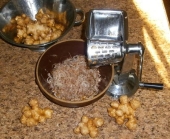
 3
3




"When there is no life in the soil it is just dirt."
"MagicDave"
 1
1




Intermountain (Cascades and Coast range) oak savannah, 550 - 600 ft elevation. USDA zone 7a. Arid summers, soggy winters

 3
3





 1
1




"When there is no life in the soil it is just dirt."
"MagicDave"
 1
1




 1
1




From my original post above:Matis wrote:
If you store Jerusalem artichokes, will they convert the inulin to fructose?
Gr. Matis
"When there is no life in the soil it is just dirt."
"MagicDave"
 3
3




Our inability to change everything should not stop us from changing what we can.
 1
1




"When there is no life in the soil it is just dirt."
"MagicDave"
 1
1




 2
2




Brice Moss wrote:
sweet potatoes are really hard to grow here on the wet side of the cascades or so I hear. I happen to find them detestable, so I haven't tried but I like all of the sun-chokes I have eaten.
"When there is no life in the soil it is just dirt."
"MagicDave"

 1
1




Our inability to change everything should not stop us from changing what we can.
 3
3




It's time to get positive about negative thinking  -Art Donnelly
-Art Donnelly
 5
5




 1
1





It's time to get positive about negative thinking  -Art Donnelly
-Art Donnelly
 2
2





 1
1




 1
1




 1
1




You can't fight the waves but you can learn to surf.
 5
5













 1
1




Scott H.
Check out my house project!
 2
2




Brenda
Bloom where you are planted.
http://restfultrailsfoodforestgarden.blogspot.com/
 3
3




For unlimited return on all your investments - Make your deposits at 'The Entangled Bank' !




It can be done!
 1
1




Brenda
Bloom where you are planted.
http://restfultrailsfoodforestgarden.blogspot.com/
 5
5




It can be done!
 4
4




S Haze wrote:last year, around this time, i tried pickling some raw sunchokes. they tasted great and it seemed to help the gas thing. anyone else tried this or know what effect fermentation has on them?




 2
2




I do not fail, I learn what does not work.




Rebecca Fussner wrote:It is possible to use the flowers and give tubers to the critters . We dont like the roots but we do
Like pickled artichoke hearts! So pop off those flowers before they open! Pull off outer leaves and process like artichoke hearts wonderful!
 5
5





 4
4




Our inability to change everything should not stop us from changing what we can.





|
Don't MAKE me come back there with this tiny ad:
rocket mass heater risers: materials and design eBook
https://permies.com/w/risers-ebook
|






